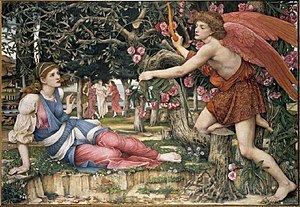Year 1877 Period Romanticism | Created 1877 | |
 | ||
Type Tempera, gold paint and gold leaf on canvas Dimensions 86.4 cm × 50.8 cm (34.0 in × 20.0 in) Similar John Roddam Spencer Stanhope artwork, Romantic artwork | ||
Love and the Maiden is a tempera on canvas by English Pre-Raphaelite artist John Roddam Spencer Stanhope, executed in 1877 and currently housed at the Fine Arts Museums of San Francisco.
History
Known as one of the "second-generation" of Pre-Raphaelites, Stanhope was among Dante Gabriel Rossetti's mural-painting party at the Oxford Union in 1857, together with Arthur Hughes, John Hungerford Pollen, Valentine Prinsep, Ned Burne-Jones and William Morris (nicknamed Topsy). He was a founder member of the Hogarth Club, a direct descendant of the Pre-Raphaelite Brotherhood.
This painting is considered one of Stanhope's best, and represents two radically different artistic phases of his life. Although he began as fervently Pre-Raphaelite in outlook, Stanhope was deeply attracted by the Aesthetic movement during the 1860s. Love and the Maiden is a succinct mingling of these two equally formative phases in his career. Its presence in the 1877 exhibition at the Grosvenor Gallery - Aestheticism's most famous exposé - demonstrates his adherence to the latter movement, whereas the painting's similarity to the work of Edward Burne-Jones and Dante Gabriel Rossetti - the group of dancing women in the background are similar to those portrayed by Rossetti in The Bower Meadow (1871–72) - betray Stanhope's Pre-Raphaelite background.
During his time in Oxford in 1857, Stanhope wrote that he spent most days painting with Burne-Jones; possibly as a result of this, a great deal of Burne-Jones' influence can be seen in his work - although it could be argued that Burne-Jones also drew ideas from Stanhope's work. The androgynous physiques, Grecian-style draperies and facial expressions depicted in Love and the Maiden are classic Burne-Jones hallmarks, even though the facial similarities probably also arose from use of the same models.
